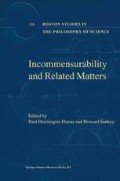Abstract
Though Kuhn and Feyerabend introduced the idea of referential incommensurability, many have found their account problematic. Subsequent developments in the theory of reference which address some of these problems are reviewed here, from the Kripke and Putnam semantics to the Ramsey-Carnap-Lewis account of theoretical terms with recent modifications due to Papineau. However Stich argues that such theories of reference can do no work towards solving issues in the philosophy of science. To overcome this objection, and to remedy some remaining shortcomings in the Ramsey apparatus used, we provide some epistemic conditions for naming. The resulting account yields a less problematic understanding of incommensurability, one that is consistent with realism.
Access this chapter
Tax calculation will be finalised at checkout
Purchases are for personal use only
Preview
Unable to display preview. Download preview PDF.
References
Beretta, M. (1993). The Enlightenment of Matter: the Definition of Chemistry from Agricola to Lavoisier. Canton: Watson Publishing International.
Bishop, M. and S. Stich. (1998). “The Flight to Reference, or How Not to Make Progress in the Philosophy of Science.” Philosophy of Science 65: 33–49.
Carnap, R. (1966). Philosophical Foundations of Physics. New York: Basic Books.
Devitt, M. (1981). Designation. New York: Columbia University Press.
Devitt, M. and K. Sterelny. (1987). Language and Reality. Cambridge: MIT Press.
Earman, J. (1977). “Against Indeterminacy.” Journal of Philosophy 74: 535–538.
Field, H. (1973). “Theory Change and Indeterminacy.” Journal of Philosophy 70: 462–481.
Fine, A. (1977). “Appendix.” Journal of Philosophy 74: 538.
Feyerabend, P. (1962). “Explanation, Reduction and Empiricism.” In H. Feigl, G. Maxwell, and M. Scriven, eds., Minnesota Studies in the Philosophy of Science, Volume 3, pp. 231–272, Minneapolis: University of Minnesota Press.
Hempel, C. (1965). Aspects of Scientific Explanation. New York: The Free Press.
Hintikka, J. (1998). “Ramsey Sentences and the Meaning of Quantifiers.” Philosophy of Science 65: 289–305
Jackson, F. (1997). “Reference and Description Revisited.” Philosophical Perspectives 12: 201–218.
Kitcher, P. (1993). The Advancement of Science. Oxford: Oxford University Press.
Kripke, S. (1980). Naming and Necessity. Cambridge Mass.: Harvard University Press.
Kroon, F. (1985). “Theoretical Terms and the Causal View of Reference.” Australasian Journal of Philosophy 63: 143–166.
Kroon, F. (1987). “Causal Descriptivism.” Australasian Journal of Philosophy 65: 1–17.
Kuhn, T. (1970). The Structure of Scientific Revolutions. 2nd edition. Chicago: University of Chicago Press.
Lavoisier, A. (1785). “Reflexions sur le phlogistique.” In Oeuvres, Volume 2 (Paris, 1862–1893), pp. 623–655.
Lewis, D. (1970). “How to Define Theoretical Terms.” Journal of Philosophy 67: 427–446.
Lewis, D. (1984). “Putnam’s Paradox.” Australasian Journal of Philosophy 62: 221–237.
Lewis, D. (1994). “David Lewis: Reduction of Mind.” In S. Guttenplan, ed., A Companion to the Philosophy of Mind, pp. 412–431, Cambridge Mass.: Blackwell.
Niiniluoto, I. (1997). “Reference Invariance and Truthlikeness.” Philosophy of Science 64: 546–554.
Nola, R. (1980). “Fixing the Reference of Theoretical Terms.” Philosophy of Science 47: 505–531.
O’Leary-Hawthorne, J. (1994). “A Corrective to the Ramsey-Lewis Account of Theoretical Terms.” Analysis 54: 105–110.
Papineau, D. (1979). Theory and Meaning. Oxford: Clarendon Press.
Papineau, D. (1996). “Theory-Dependent Terms.” Philosophy of Science 63: 1–20.
Partington, J. (1962). A History of Chemistry. London: Macmillan & Co. Ltd.
Psillos, S. (1999). Scientific Realism: How Science Tracks the Truth. Routledge: London.
Psillos, S. (2000). “Rudolf Carnap’s ‘Theoretical Concepts in Science’.” Studies in History and Philosophy of Science 31: 151–172.
Putnam, H. (1975). Mind, Language and Reality. Philosophical Papers, Volume 2. Cambridge: Cambridge University Press.
Putnam, H. (1978). Meaning and the Moral Sciences. London: Routledge and Kegan Paul.
Ramsey, F. (1990). Philosophical Papers. Cambridge: Cambridge University Press; edited by D. H. Mellor.
Sankey, H. (1994). The Incommensurability Thesis. Aldershot: Avebury.
Sankey, H. (1997). “Incommensurability: The Current State of Play.” Theoria 12: 425–445.
Semmelweis, I. (1963). The Etiology, Concept and Prophylaxis of Childbed Fever, trans. by K. Carter. Madison: University of Wisconsin Press (first published in German in 1860).
Stahl, G. (1730). Philosophical Principles of Universal Chemistry. London: Osborne and Longman.
Stich, S. (1996). The Deconstruction of the Mind. New York: Oxford University Press.
Thagard, P. (1999). How Scientists Explain Disease. Princeton: Princeton University Press.
Thomson, J. (1897). “Cathode Rays.” Philosophical Magazine 44: 293–316.
Tuomela, R. (1973). Theoretical Concepts. Vienna and New York: Springer-Verlag.
Zytkow, J. and H. Simon. (1986). “A Theory of Historical Discovery: The Construction of Componental Models.” Machine Learning 1: 107–137.
Author information
Authors and Affiliations
Editor information
Editors and Affiliations
Rights and permissions
Copyright information
© 2001 Springer Science+Business Media Dordrecht
About this chapter
Cite this chapter
Kroon, F., Nola, R. (2001). Ramsification, Reference Fixing and Incommensurability. In: Hoyningen-Huene, P., Sankey, H. (eds) Incommensurability and Related Matters. Boston Studies in the Philosophy of Science, vol 216. Springer, Dordrecht. https://doi.org/10.1007/978-94-015-9680-0_3
Download citation
DOI: https://doi.org/10.1007/978-94-015-9680-0_3
Publisher Name: Springer, Dordrecht
Print ISBN: 978-90-481-5709-9
Online ISBN: 978-94-015-9680-0
eBook Packages: Springer Book Archive

